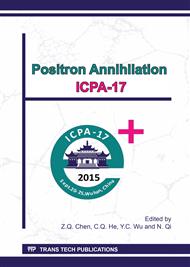p.284
p.288
p.295
p.299
p.303
p.309
p.313
p.317
p.324
Comparative Study of Time-Dependent PAES and XPS on a Ni/Pd Surface
Abstract:
We report on time-dependent Positron annihilation induced Auger Electron Spectroscopy (PAES) study on 0.5 monolayers (ML) Ni on polycrystalline Pd accompanied by complementary X-ray induced Photoelectron Spectroscopy (XPS). The normalized PAES spectra showed a significant decrease in the Ni intensity and an increase in the Pd intensity as a function of time. To rule out varying influence on the elements e.g. from surface contaminates due to the residual gas, a time-dependent XPS analysis was performed on pure Ni and Pd as well as to analyze the main contaminants C and O. The O fraction was found to be constant within the measurement time and the time constants for C significantly differ from those of Ni and Pd in the PAES data. Consequently, it was concluded that the PAES data show a superposition of C contamination and structural changes at the surface of Ni/Pd.
Info:
Periodical:
Pages:
313-316
Citation:
Online since:
March 2017
Price:
Сopyright:
© 2016 Trans Tech Publications Ltd. All Rights Reserved
Share:
Citation:


